Business Environment Report: Economic Factors and Stakeholders
VerifiedAdded on 2020/06/04
|11
|2974
|101
Report
AI Summary
This report provides a comprehensive analysis of the business environment, examining various aspects that influence business operations. It begins by defining different types of businesses, including public and private entities, and explores diverse ownership structures such as sole traders, partnerships, and franchises. The report then delves into the impact of stakeholders, including customers, employees, suppliers, owners, and the community, on organizational purpose, using Asda and The Prince's Trust as case studies. Further analysis covers organizational structures, highlighting functional areas and how they contribute to fulfilling business objectives. The report also examines the influence of economic environments, such as employment, income, inflation, and interest rates, on business activities, along with political, legal, and social factors. The report concludes by discussing the effects of economic changes, like recessions, and government policies on businesses. Overall, the report provides a detailed understanding of the complex factors that shape the business environment and their implications for organizations.
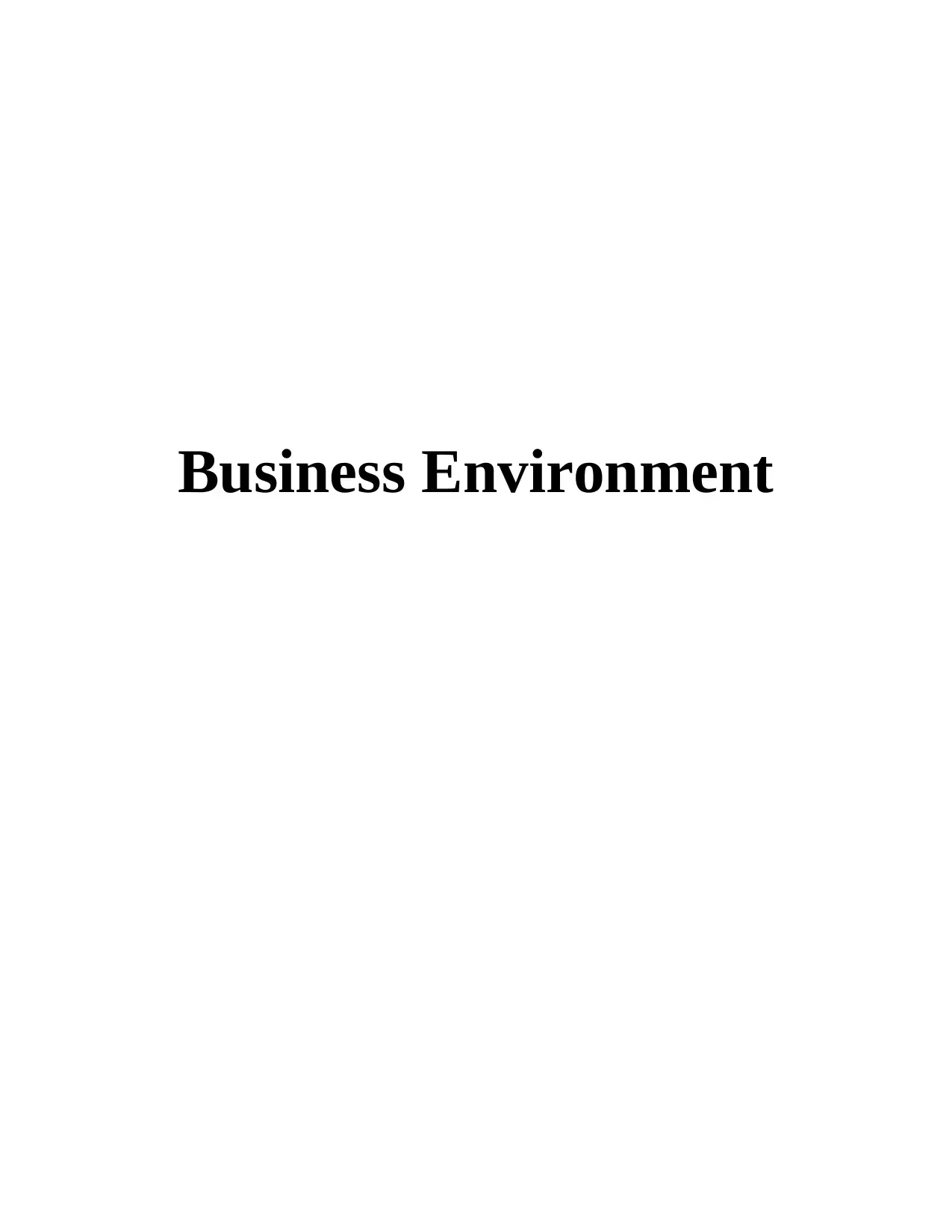
Business Environment
Paraphrase This Document
Need a fresh take? Get an instant paraphrase of this document with our AI Paraphraser
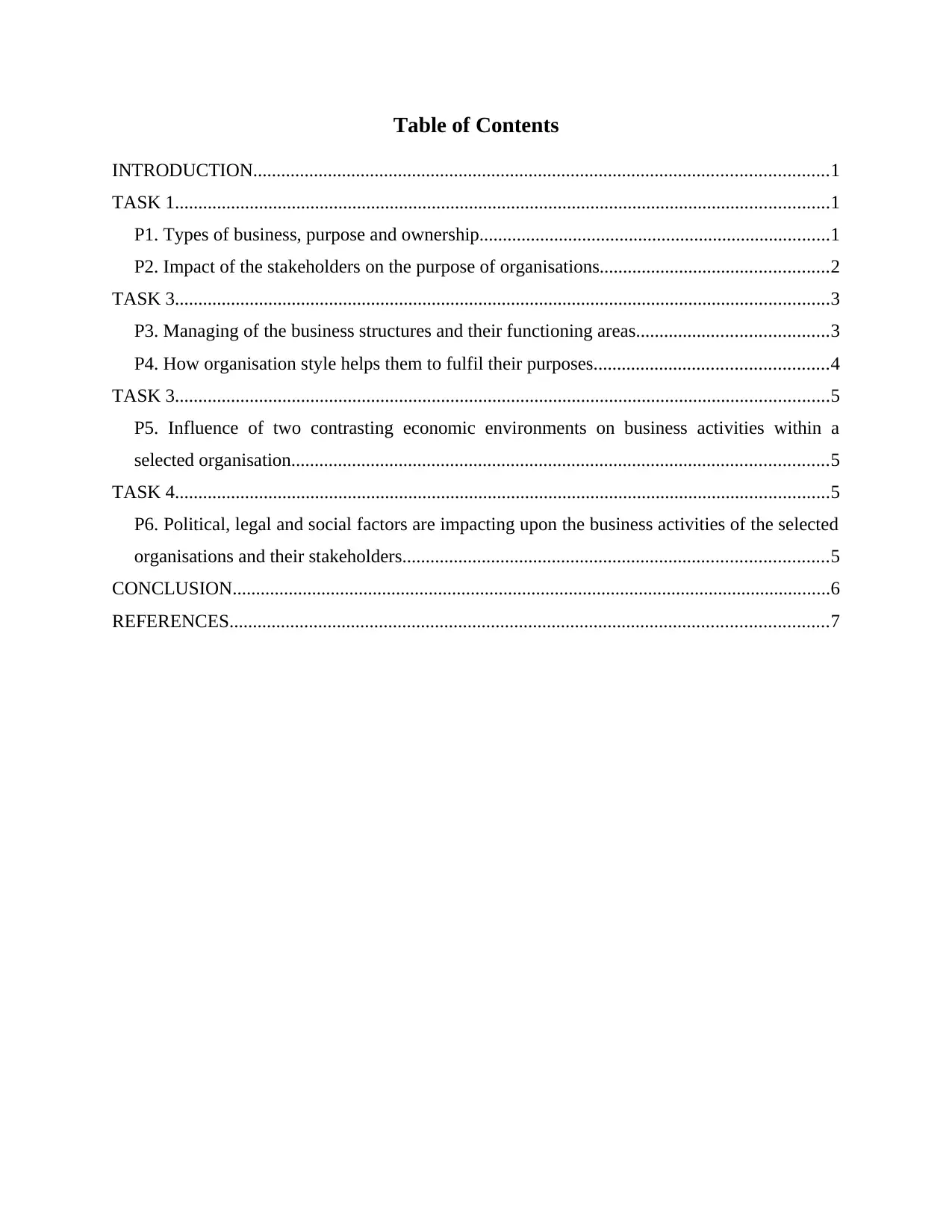
Table of Contents
INTRODUCTION...........................................................................................................................1
TASK 1............................................................................................................................................1
P1. Types of business, purpose and ownership...........................................................................1
P2. Impact of the stakeholders on the purpose of organisations.................................................2
TASK 3............................................................................................................................................3
P3. Managing of the business structures and their functioning areas.........................................3
P4. How organisation style helps them to fulfil their purposes..................................................4
TASK 3............................................................................................................................................5
P5. Influence of two contrasting economic environments on business activities within a
selected organisation...................................................................................................................5
TASK 4............................................................................................................................................5
P6. Political, legal and social factors are impacting upon the business activities of the selected
organisations and their stakeholders...........................................................................................5
CONCLUSION................................................................................................................................6
REFERENCES................................................................................................................................7
INTRODUCTION...........................................................................................................................1
TASK 1............................................................................................................................................1
P1. Types of business, purpose and ownership...........................................................................1
P2. Impact of the stakeholders on the purpose of organisations.................................................2
TASK 3............................................................................................................................................3
P3. Managing of the business structures and their functioning areas.........................................3
P4. How organisation style helps them to fulfil their purposes..................................................4
TASK 3............................................................................................................................................5
P5. Influence of two contrasting economic environments on business activities within a
selected organisation...................................................................................................................5
TASK 4............................................................................................................................................5
P6. Political, legal and social factors are impacting upon the business activities of the selected
organisations and their stakeholders...........................................................................................5
CONCLUSION................................................................................................................................6
REFERENCES................................................................................................................................7

⊘ This is a preview!⊘
Do you want full access?
Subscribe today to unlock all pages.

Trusted by 1+ million students worldwide
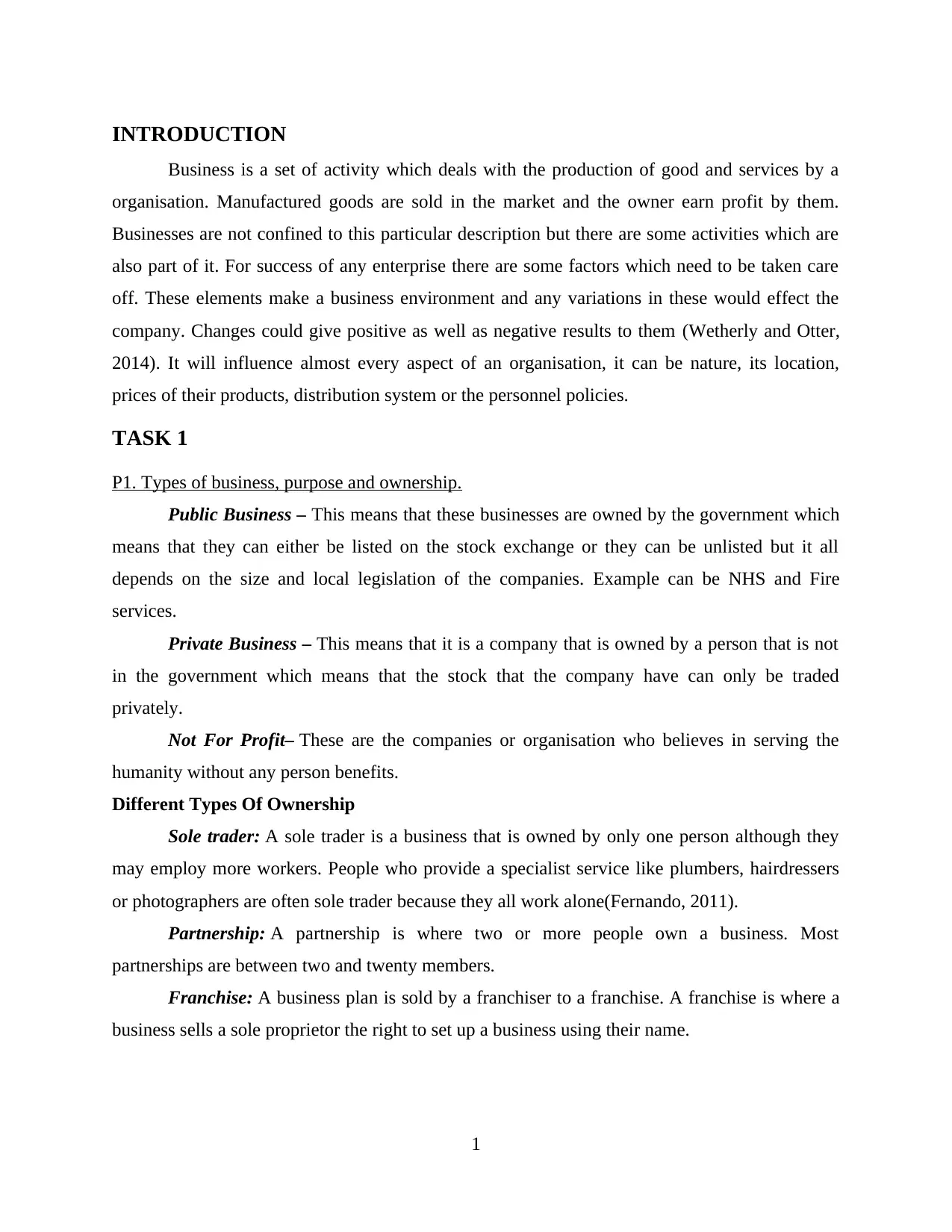
INTRODUCTION
Business is a set of activity which deals with the production of good and services by a
organisation. Manufactured goods are sold in the market and the owner earn profit by them.
Businesses are not confined to this particular description but there are some activities which are
also part of it. For success of any enterprise there are some factors which need to be taken care
off. These elements make a business environment and any variations in these would effect the
company. Changes could give positive as well as negative results to them (Wetherly and Otter,
2014). It will influence almost every aspect of an organisation, it can be nature, its location,
prices of their products, distribution system or the personnel policies.
TASK 1
P1. Types of business, purpose and ownership.
Public Business – This means that these businesses are owned by the government which
means that they can either be listed on the stock exchange or they can be unlisted but it all
depends on the size and local legislation of the companies. Example can be NHS and Fire
services.
Private Business – This means that it is a company that is owned by a person that is not
in the government which means that the stock that the company have can only be traded
privately.
Not For Profit– These are the companies or organisation who believes in serving the
humanity without any person benefits.
Different Types Of Ownership
Sole trader: A sole trader is a business that is owned by only one person although they
may employ more workers. People who provide a specialist service like plumbers, hairdressers
or photographers are often sole trader because they all work alone(Fernando, 2011).
Partnership: A partnership is where two or more people own a business. Most
partnerships are between two and twenty members.
Franchise: A business plan is sold by a franchiser to a franchise. A franchise is where a
business sells a sole proprietor the right to set up a business using their name.
1
Business is a set of activity which deals with the production of good and services by a
organisation. Manufactured goods are sold in the market and the owner earn profit by them.
Businesses are not confined to this particular description but there are some activities which are
also part of it. For success of any enterprise there are some factors which need to be taken care
off. These elements make a business environment and any variations in these would effect the
company. Changes could give positive as well as negative results to them (Wetherly and Otter,
2014). It will influence almost every aspect of an organisation, it can be nature, its location,
prices of their products, distribution system or the personnel policies.
TASK 1
P1. Types of business, purpose and ownership.
Public Business – This means that these businesses are owned by the government which
means that they can either be listed on the stock exchange or they can be unlisted but it all
depends on the size and local legislation of the companies. Example can be NHS and Fire
services.
Private Business – This means that it is a company that is owned by a person that is not
in the government which means that the stock that the company have can only be traded
privately.
Not For Profit– These are the companies or organisation who believes in serving the
humanity without any person benefits.
Different Types Of Ownership
Sole trader: A sole trader is a business that is owned by only one person although they
may employ more workers. People who provide a specialist service like plumbers, hairdressers
or photographers are often sole trader because they all work alone(Fernando, 2011).
Partnership: A partnership is where two or more people own a business. Most
partnerships are between two and twenty members.
Franchise: A business plan is sold by a franchiser to a franchise. A franchise is where a
business sells a sole proprietor the right to set up a business using their name.
1
Paraphrase This Document
Need a fresh take? Get an instant paraphrase of this document with our AI Paraphraser
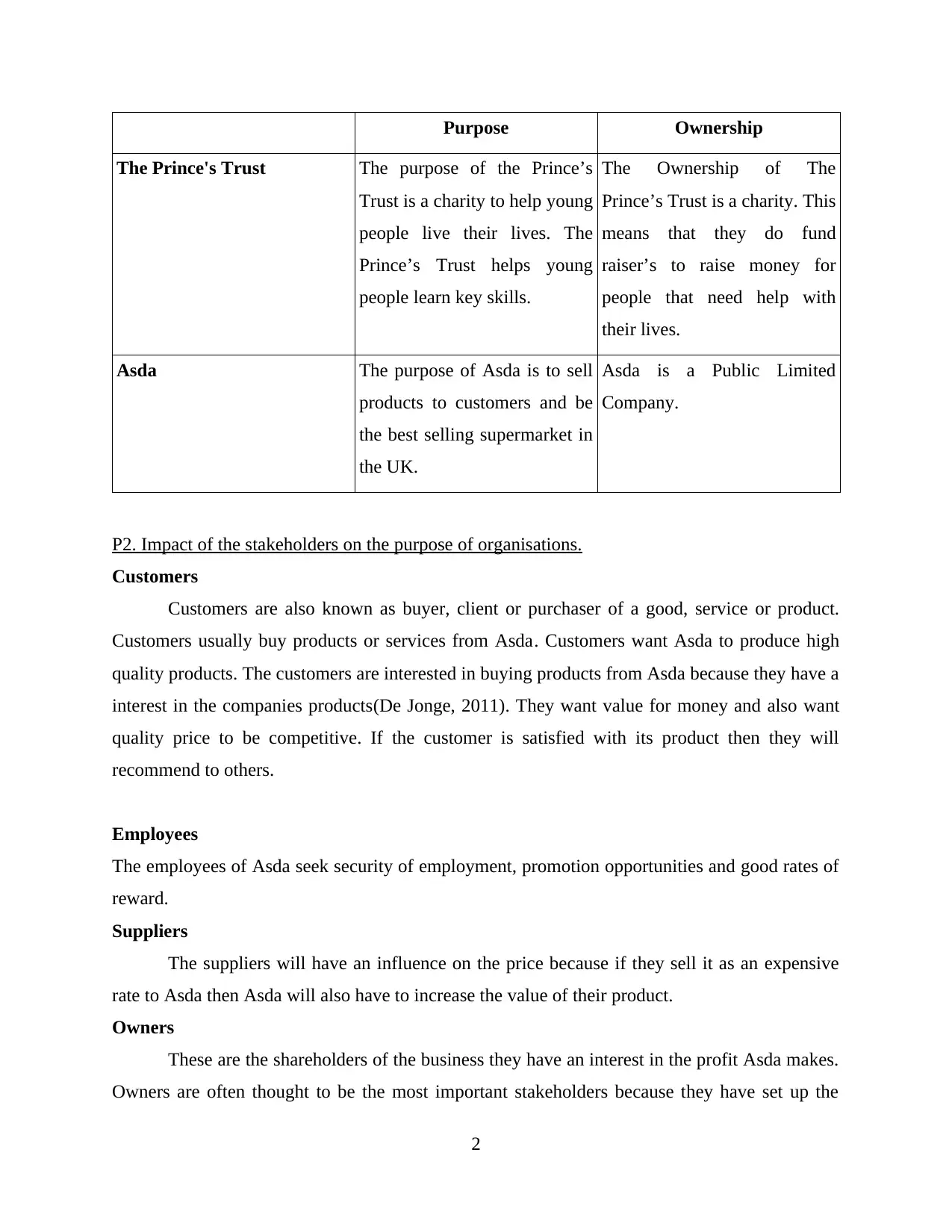
Purpose Ownership
The Prince's Trust The purpose of the Prince’s
Trust is a charity to help young
people live their lives. The
Prince’s Trust helps young
people learn key skills.
The Ownership of The
Prince’s Trust is a charity. This
means that they do fund
raiser’s to raise money for
people that need help with
their lives.
Asda The purpose of Asda is to sell
products to customers and be
the best selling supermarket in
the UK.
Asda is a Public Limited
Company.
P2. Impact of the stakeholders on the purpose of organisations.
Customers
Customers are also known as buyer, client or purchaser of a good, service or product.
Customers usually buy products or services from Asda. Customers want Asda to produce high
quality products. The customers are interested in buying products from Asda because they have a
interest in the companies products(De Jonge, 2011). They want value for money and also want
quality price to be competitive. If the customer is satisfied with its product then they will
recommend to others.
Employees
The employees of Asda seek security of employment, promotion opportunities and good rates of
reward.
Suppliers
The suppliers will have an influence on the price because if they sell it as an expensive
rate to Asda then Asda will also have to increase the value of their product.
Owners
These are the shareholders of the business they have an interest in the profit Asda makes.
Owners are often thought to be the most important stakeholders because they have set up the
2
The Prince's Trust The purpose of the Prince’s
Trust is a charity to help young
people live their lives. The
Prince’s Trust helps young
people learn key skills.
The Ownership of The
Prince’s Trust is a charity. This
means that they do fund
raiser’s to raise money for
people that need help with
their lives.
Asda The purpose of Asda is to sell
products to customers and be
the best selling supermarket in
the UK.
Asda is a Public Limited
Company.
P2. Impact of the stakeholders on the purpose of organisations.
Customers
Customers are also known as buyer, client or purchaser of a good, service or product.
Customers usually buy products or services from Asda. Customers want Asda to produce high
quality products. The customers are interested in buying products from Asda because they have a
interest in the companies products(De Jonge, 2011). They want value for money and also want
quality price to be competitive. If the customer is satisfied with its product then they will
recommend to others.
Employees
The employees of Asda seek security of employment, promotion opportunities and good rates of
reward.
Suppliers
The suppliers will have an influence on the price because if they sell it as an expensive
rate to Asda then Asda will also have to increase the value of their product.
Owners
These are the shareholders of the business they have an interest in the profit Asda makes.
Owners are often thought to be the most important stakeholders because they have set up the
2
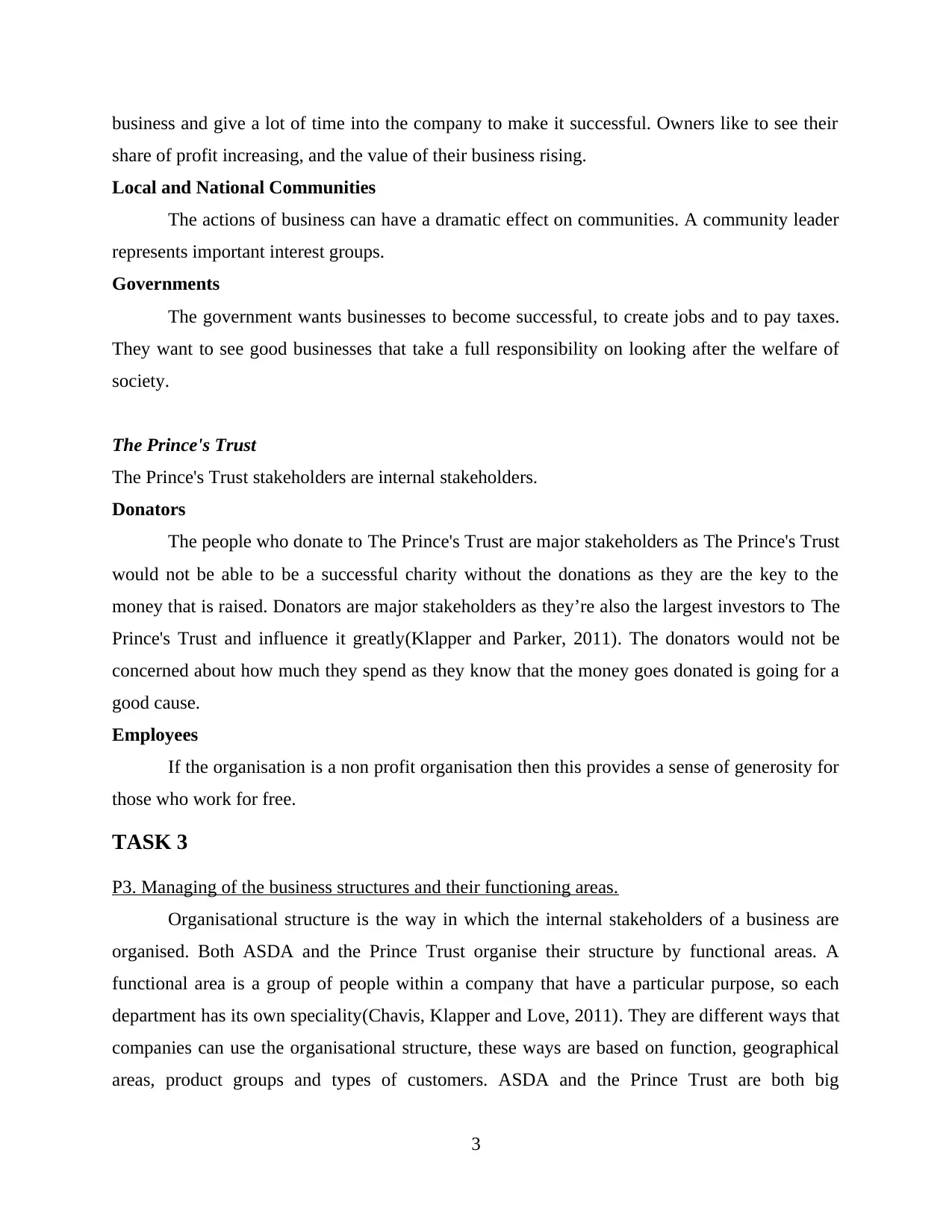
business and give a lot of time into the company to make it successful. Owners like to see their
share of profit increasing, and the value of their business rising.
Local and National Communities
The actions of business can have a dramatic effect on communities. A community leader
represents important interest groups.
Governments
The government wants businesses to become successful, to create jobs and to pay taxes.
They want to see good businesses that take a full responsibility on looking after the welfare of
society.
The Prince's Trust
The Prince's Trust stakeholders are internal stakeholders.
Donators
The people who donate to The Prince's Trust are major stakeholders as The Prince's Trust
would not be able to be a successful charity without the donations as they are the key to the
money that is raised. Donators are major stakeholders as they’re also the largest investors to The
Prince's Trust and influence it greatly(Klapper and Parker, 2011). The donators would not be
concerned about how much they spend as they know that the money goes donated is going for a
good cause.
Employees
If the organisation is a non profit organisation then this provides a sense of generosity for
those who work for free.
TASK 3
P3. Managing of the business structures and their functioning areas.
Organisational structure is the way in which the internal stakeholders of a business are
organised. Both ASDA and the Prince Trust organise their structure by functional areas. A
functional area is a group of people within a company that have a particular purpose, so each
department has its own speciality(Chavis, Klapper and Love, 2011). They are different ways that
companies can use the organisational structure, these ways are based on function, geographical
areas, product groups and types of customers. ASDA and the Prince Trust are both big
3
share of profit increasing, and the value of their business rising.
Local and National Communities
The actions of business can have a dramatic effect on communities. A community leader
represents important interest groups.
Governments
The government wants businesses to become successful, to create jobs and to pay taxes.
They want to see good businesses that take a full responsibility on looking after the welfare of
society.
The Prince's Trust
The Prince's Trust stakeholders are internal stakeholders.
Donators
The people who donate to The Prince's Trust are major stakeholders as The Prince's Trust
would not be able to be a successful charity without the donations as they are the key to the
money that is raised. Donators are major stakeholders as they’re also the largest investors to The
Prince's Trust and influence it greatly(Klapper and Parker, 2011). The donators would not be
concerned about how much they spend as they know that the money goes donated is going for a
good cause.
Employees
If the organisation is a non profit organisation then this provides a sense of generosity for
those who work for free.
TASK 3
P3. Managing of the business structures and their functioning areas.
Organisational structure is the way in which the internal stakeholders of a business are
organised. Both ASDA and the Prince Trust organise their structure by functional areas. A
functional area is a group of people within a company that have a particular purpose, so each
department has its own speciality(Chavis, Klapper and Love, 2011). They are different ways that
companies can use the organisational structure, these ways are based on function, geographical
areas, product groups and types of customers. ASDA and the Prince Trust are both big
3
⊘ This is a preview!⊘
Do you want full access?
Subscribe today to unlock all pages.

Trusted by 1+ million students worldwide
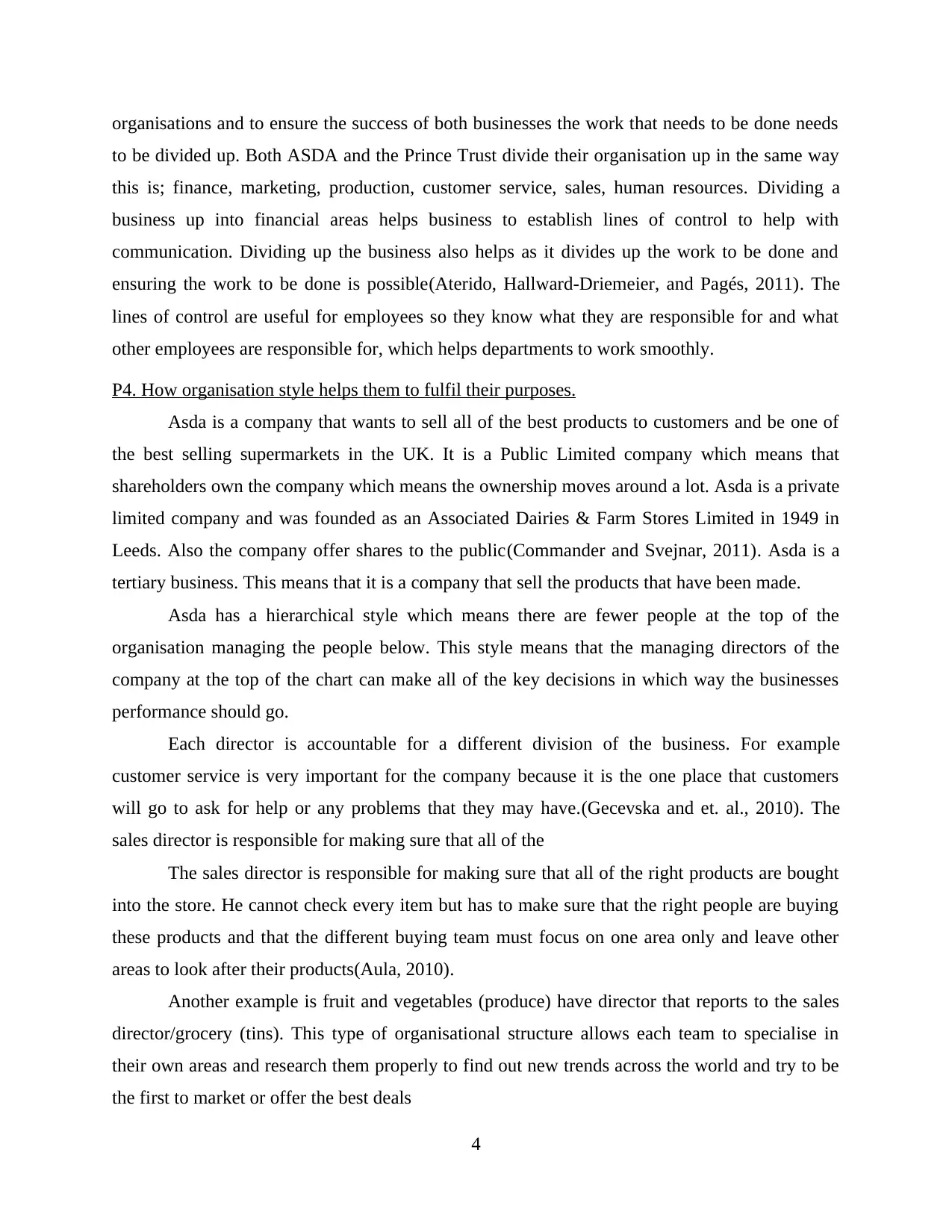
organisations and to ensure the success of both businesses the work that needs to be done needs
to be divided up. Both ASDA and the Prince Trust divide their organisation up in the same way
this is; finance, marketing, production, customer service, sales, human resources. Dividing a
business up into financial areas helps business to establish lines of control to help with
communication. Dividing up the business also helps as it divides up the work to be done and
ensuring the work to be done is possible(Aterido, Hallward-Driemeier, and Pagés, 2011). The
lines of control are useful for employees so they know what they are responsible for and what
other employees are responsible for, which helps departments to work smoothly.
P4. How organisation style helps them to fulfil their purposes.
Asda is a company that wants to sell all of the best products to customers and be one of
the best selling supermarkets in the UK. It is a Public Limited company which means that
shareholders own the company which means the ownership moves around a lot. Asda is a private
limited company and was founded as an Associated Dairies & Farm Stores Limited in 1949 in
Leeds. Also the company offer shares to the public(Commander and Svejnar, 2011). Asda is a
tertiary business. This means that it is a company that sell the products that have been made.
Asda has a hierarchical style which means there are fewer people at the top of the
organisation managing the people below. This style means that the managing directors of the
company at the top of the chart can make all of the key decisions in which way the businesses
performance should go.
Each director is accountable for a different division of the business. For example
customer service is very important for the company because it is the one place that customers
will go to ask for help or any problems that they may have.(Gecevska and et. al., 2010). The
sales director is responsible for making sure that all of the
The sales director is responsible for making sure that all of the right products are bought
into the store. He cannot check every item but has to make sure that the right people are buying
these products and that the different buying team must focus on one area only and leave other
areas to look after their products(Aula, 2010).
Another example is fruit and vegetables (produce) have director that reports to the sales
director/grocery (tins). This type of organisational structure allows each team to specialise in
their own areas and research them properly to find out new trends across the world and try to be
the first to market or offer the best deals
4
to be divided up. Both ASDA and the Prince Trust divide their organisation up in the same way
this is; finance, marketing, production, customer service, sales, human resources. Dividing a
business up into financial areas helps business to establish lines of control to help with
communication. Dividing up the business also helps as it divides up the work to be done and
ensuring the work to be done is possible(Aterido, Hallward-Driemeier, and Pagés, 2011). The
lines of control are useful for employees so they know what they are responsible for and what
other employees are responsible for, which helps departments to work smoothly.
P4. How organisation style helps them to fulfil their purposes.
Asda is a company that wants to sell all of the best products to customers and be one of
the best selling supermarkets in the UK. It is a Public Limited company which means that
shareholders own the company which means the ownership moves around a lot. Asda is a private
limited company and was founded as an Associated Dairies & Farm Stores Limited in 1949 in
Leeds. Also the company offer shares to the public(Commander and Svejnar, 2011). Asda is a
tertiary business. This means that it is a company that sell the products that have been made.
Asda has a hierarchical style which means there are fewer people at the top of the
organisation managing the people below. This style means that the managing directors of the
company at the top of the chart can make all of the key decisions in which way the businesses
performance should go.
Each director is accountable for a different division of the business. For example
customer service is very important for the company because it is the one place that customers
will go to ask for help or any problems that they may have.(Gecevska and et. al., 2010). The
sales director is responsible for making sure that all of the
The sales director is responsible for making sure that all of the right products are bought
into the store. He cannot check every item but has to make sure that the right people are buying
these products and that the different buying team must focus on one area only and leave other
areas to look after their products(Aula, 2010).
Another example is fruit and vegetables (produce) have director that reports to the sales
director/grocery (tins). This type of organisational structure allows each team to specialise in
their own areas and research them properly to find out new trends across the world and try to be
the first to market or offer the best deals
4
Paraphrase This Document
Need a fresh take? Get an instant paraphrase of this document with our AI Paraphraser
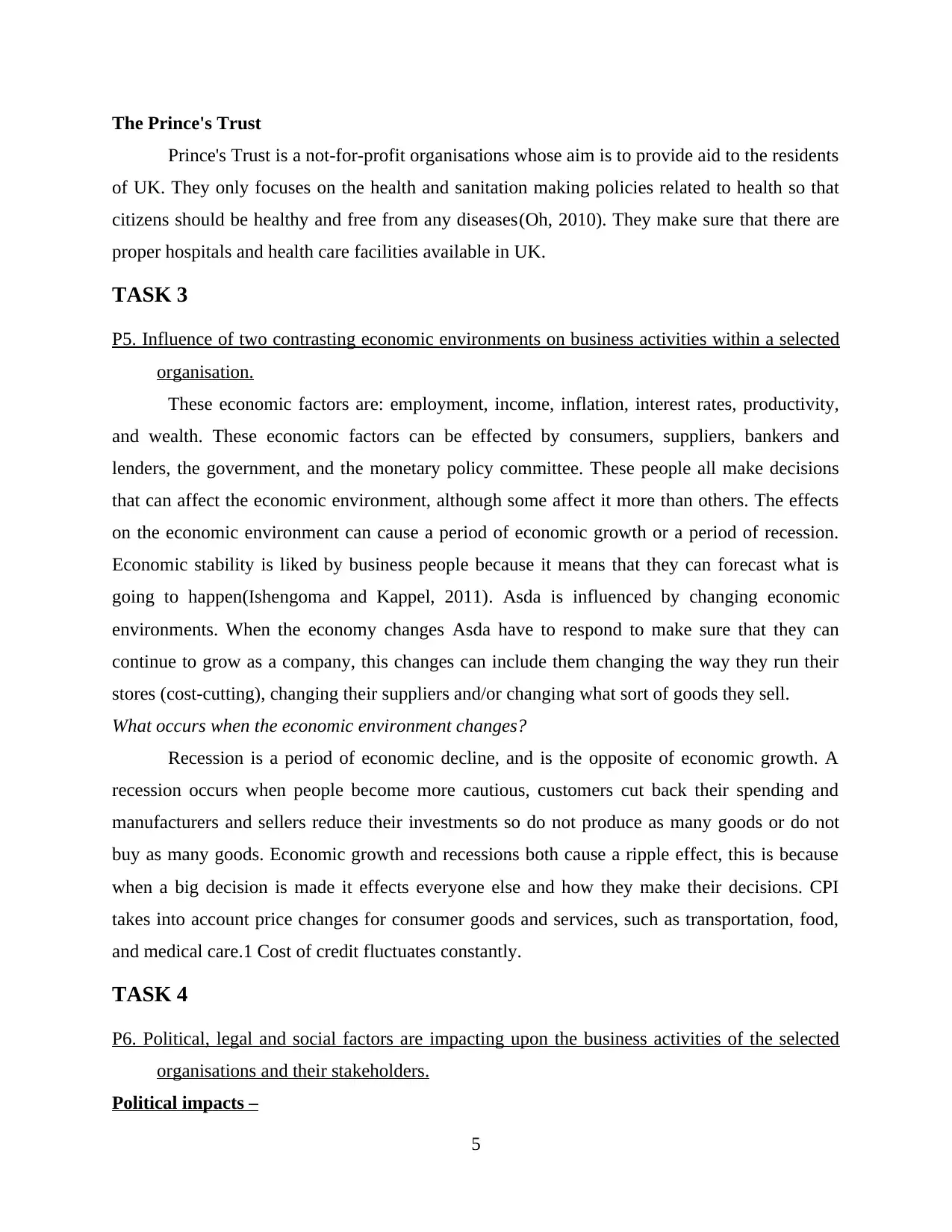
The Prince's Trust
Prince's Trust is a not-for-profit organisations whose aim is to provide aid to the residents
of UK. They only focuses on the health and sanitation making policies related to health so that
citizens should be healthy and free from any diseases(Oh, 2010). They make sure that there are
proper hospitals and health care facilities available in UK.
TASK 3
P5. Influence of two contrasting economic environments on business activities within a selected
organisation.
These economic factors are: employment, income, inflation, interest rates, productivity,
and wealth. These economic factors can be effected by consumers, suppliers, bankers and
lenders, the government, and the monetary policy committee. These people all make decisions
that can affect the economic environment, although some affect it more than others. The effects
on the economic environment can cause a period of economic growth or a period of recession.
Economic stability is liked by business people because it means that they can forecast what is
going to happen(Ishengoma and Kappel, 2011). Asda is influenced by changing economic
environments. When the economy changes Asda have to respond to make sure that they can
continue to grow as a company, this changes can include them changing the way they run their
stores (cost-cutting), changing their suppliers and/or changing what sort of goods they sell.
What occurs when the economic environment changes?
Recession is a period of economic decline, and is the opposite of economic growth. A
recession occurs when people become more cautious, customers cut back their spending and
manufacturers and sellers reduce their investments so do not produce as many goods or do not
buy as many goods. Economic growth and recessions both cause a ripple effect, this is because
when a big decision is made it effects everyone else and how they make their decisions. CPI
takes into account price changes for consumer goods and services, such as transportation, food,
and medical care.1 Cost of credit fluctuates constantly.
TASK 4
P6. Political, legal and social factors are impacting upon the business activities of the selected
organisations and their stakeholders.
Political impacts –
5
Prince's Trust is a not-for-profit organisations whose aim is to provide aid to the residents
of UK. They only focuses on the health and sanitation making policies related to health so that
citizens should be healthy and free from any diseases(Oh, 2010). They make sure that there are
proper hospitals and health care facilities available in UK.
TASK 3
P5. Influence of two contrasting economic environments on business activities within a selected
organisation.
These economic factors are: employment, income, inflation, interest rates, productivity,
and wealth. These economic factors can be effected by consumers, suppliers, bankers and
lenders, the government, and the monetary policy committee. These people all make decisions
that can affect the economic environment, although some affect it more than others. The effects
on the economic environment can cause a period of economic growth or a period of recession.
Economic stability is liked by business people because it means that they can forecast what is
going to happen(Ishengoma and Kappel, 2011). Asda is influenced by changing economic
environments. When the economy changes Asda have to respond to make sure that they can
continue to grow as a company, this changes can include them changing the way they run their
stores (cost-cutting), changing their suppliers and/or changing what sort of goods they sell.
What occurs when the economic environment changes?
Recession is a period of economic decline, and is the opposite of economic growth. A
recession occurs when people become more cautious, customers cut back their spending and
manufacturers and sellers reduce their investments so do not produce as many goods or do not
buy as many goods. Economic growth and recessions both cause a ripple effect, this is because
when a big decision is made it effects everyone else and how they make their decisions. CPI
takes into account price changes for consumer goods and services, such as transportation, food,
and medical care.1 Cost of credit fluctuates constantly.
TASK 4
P6. Political, legal and social factors are impacting upon the business activities of the selected
organisations and their stakeholders.
Political impacts –
5
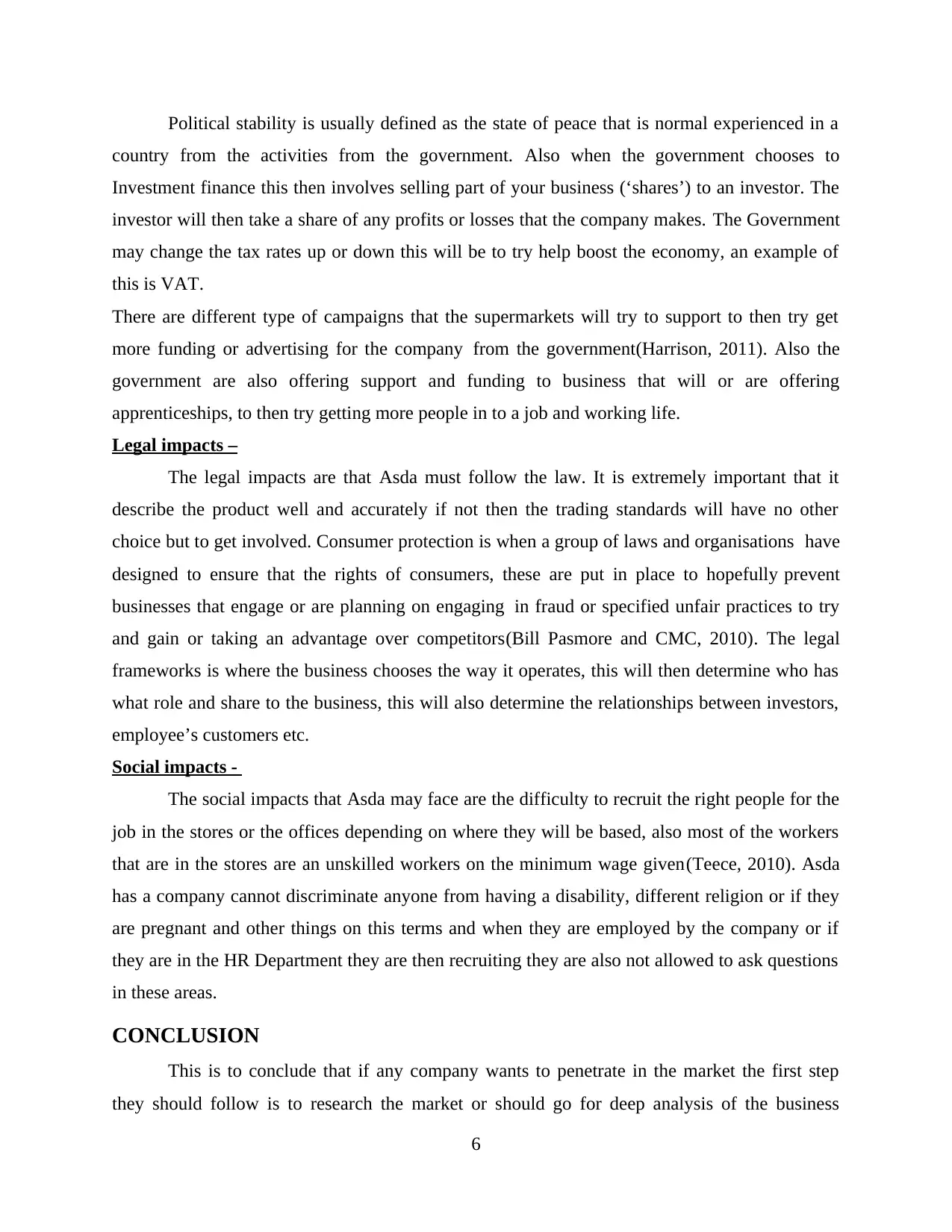
Political stability is usually defined as the state of peace that is normal experienced in a
country from the activities from the government. Also when the government chooses to
Investment finance this then involves selling part of your business (‘shares’) to an investor. The
investor will then take a share of any profits or losses that the company makes. The Government
may change the tax rates up or down this will be to try help boost the economy, an example of
this is VAT.
There are different type of campaigns that the supermarkets will try to support to then try get
more funding or advertising for the company from the government(Harrison, 2011). Also the
government are also offering support and funding to business that will or are offering
apprenticeships, to then try getting more people in to a job and working life.
Legal impacts –
The legal impacts are that Asda must follow the law. It is extremely important that it
describe the product well and accurately if not then the trading standards will have no other
choice but to get involved. Consumer protection is when a group of laws and organisations have
designed to ensure that the rights of consumers, these are put in place to hopefully prevent
businesses that engage or are planning on engaging in fraud or specified unfair practices to try
and gain or taking an advantage over competitors(Bill Pasmore and CMC, 2010). The legal
frameworks is where the business chooses the way it operates, this will then determine who has
what role and share to the business, this will also determine the relationships between investors,
employee’s customers etc.
Social impacts -
The social impacts that Asda may face are the difficulty to recruit the right people for the
job in the stores or the offices depending on where they will be based, also most of the workers
that are in the stores are an unskilled workers on the minimum wage given(Teece, 2010). Asda
has a company cannot discriminate anyone from having a disability, different religion or if they
are pregnant and other things on this terms and when they are employed by the company or if
they are in the HR Department they are then recruiting they are also not allowed to ask questions
in these areas.
CONCLUSION
This is to conclude that if any company wants to penetrate in the market the first step
they should follow is to research the market or should go for deep analysis of the business
6
country from the activities from the government. Also when the government chooses to
Investment finance this then involves selling part of your business (‘shares’) to an investor. The
investor will then take a share of any profits or losses that the company makes. The Government
may change the tax rates up or down this will be to try help boost the economy, an example of
this is VAT.
There are different type of campaigns that the supermarkets will try to support to then try get
more funding or advertising for the company from the government(Harrison, 2011). Also the
government are also offering support and funding to business that will or are offering
apprenticeships, to then try getting more people in to a job and working life.
Legal impacts –
The legal impacts are that Asda must follow the law. It is extremely important that it
describe the product well and accurately if not then the trading standards will have no other
choice but to get involved. Consumer protection is when a group of laws and organisations have
designed to ensure that the rights of consumers, these are put in place to hopefully prevent
businesses that engage or are planning on engaging in fraud or specified unfair practices to try
and gain or taking an advantage over competitors(Bill Pasmore and CMC, 2010). The legal
frameworks is where the business chooses the way it operates, this will then determine who has
what role and share to the business, this will also determine the relationships between investors,
employee’s customers etc.
Social impacts -
The social impacts that Asda may face are the difficulty to recruit the right people for the
job in the stores or the offices depending on where they will be based, also most of the workers
that are in the stores are an unskilled workers on the minimum wage given(Teece, 2010). Asda
has a company cannot discriminate anyone from having a disability, different religion or if they
are pregnant and other things on this terms and when they are employed by the company or if
they are in the HR Department they are then recruiting they are also not allowed to ask questions
in these areas.
CONCLUSION
This is to conclude that if any company wants to penetrate in the market the first step
they should follow is to research the market or should go for deep analysis of the business
6
⊘ This is a preview!⊘
Do you want full access?
Subscribe today to unlock all pages.

Trusted by 1+ million students worldwide

environment. Because business environment is uncertain so by having a knowledge of its will
definitely help them to grow their businesses.
7
definitely help them to grow their businesses.
7
Paraphrase This Document
Need a fresh take? Get an instant paraphrase of this document with our AI Paraphraser
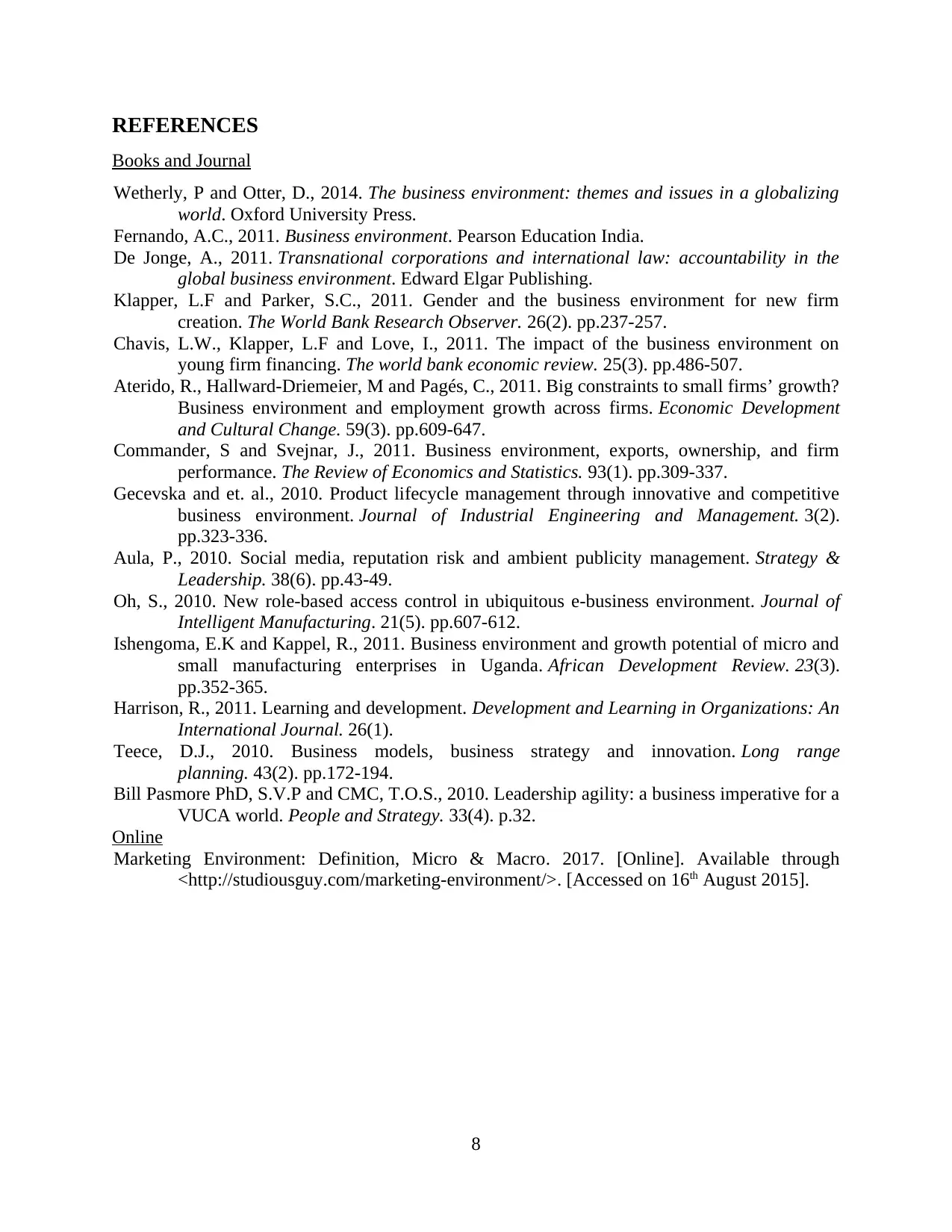
REFERENCES
Books and Journal
Wetherly, P and Otter, D., 2014. The business environment: themes and issues in a globalizing
world. Oxford University Press.
Fernando, A.C., 2011. Business environment. Pearson Education India.
De Jonge, A., 2011. Transnational corporations and international law: accountability in the
global business environment. Edward Elgar Publishing.
Klapper, L.F and Parker, S.C., 2011. Gender and the business environment for new firm
creation. The World Bank Research Observer. 26(2). pp.237-257.
Chavis, L.W., Klapper, L.F and Love, I., 2011. The impact of the business environment on
young firm financing. The world bank economic review. 25(3). pp.486-507.
Aterido, R., Hallward-Driemeier, M and Pagés, C., 2011. Big constraints to small firms’ growth?
Business environment and employment growth across firms. Economic Development
and Cultural Change. 59(3). pp.609-647.
Commander, S and Svejnar, J., 2011. Business environment, exports, ownership, and firm
performance. The Review of Economics and Statistics. 93(1). pp.309-337.
Gecevska and et. al., 2010. Product lifecycle management through innovative and competitive
business environment. Journal of Industrial Engineering and Management. 3(2).
pp.323-336.
Aula, P., 2010. Social media, reputation risk and ambient publicity management. Strategy &
Leadership. 38(6). pp.43-49.
Oh, S., 2010. New role-based access control in ubiquitous e-business environment. Journal of
Intelligent Manufacturing. 21(5). pp.607-612.
Ishengoma, E.K and Kappel, R., 2011. Business environment and growth potential of micro and
small manufacturing enterprises in Uganda. African Development Review. 23(3).
pp.352-365.
Harrison, R., 2011. Learning and development. Development and Learning in Organizations: An
International Journal. 26(1).
Teece, D.J., 2010. Business models, business strategy and innovation. Long range
planning. 43(2). pp.172-194.
Bill Pasmore PhD, S.V.P and CMC, T.O.S., 2010. Leadership agility: a business imperative for a
VUCA world. People and Strategy. 33(4). p.32.
Online
Marketing Environment: Definition, Micro & Macro. 2017. [Online]. Available through
<http://studiousguy.com/marketing-environment/>. [Accessed on 16th August 2015].
8
Books and Journal
Wetherly, P and Otter, D., 2014. The business environment: themes and issues in a globalizing
world. Oxford University Press.
Fernando, A.C., 2011. Business environment. Pearson Education India.
De Jonge, A., 2011. Transnational corporations and international law: accountability in the
global business environment. Edward Elgar Publishing.
Klapper, L.F and Parker, S.C., 2011. Gender and the business environment for new firm
creation. The World Bank Research Observer. 26(2). pp.237-257.
Chavis, L.W., Klapper, L.F and Love, I., 2011. The impact of the business environment on
young firm financing. The world bank economic review. 25(3). pp.486-507.
Aterido, R., Hallward-Driemeier, M and Pagés, C., 2011. Big constraints to small firms’ growth?
Business environment and employment growth across firms. Economic Development
and Cultural Change. 59(3). pp.609-647.
Commander, S and Svejnar, J., 2011. Business environment, exports, ownership, and firm
performance. The Review of Economics and Statistics. 93(1). pp.309-337.
Gecevska and et. al., 2010. Product lifecycle management through innovative and competitive
business environment. Journal of Industrial Engineering and Management. 3(2).
pp.323-336.
Aula, P., 2010. Social media, reputation risk and ambient publicity management. Strategy &
Leadership. 38(6). pp.43-49.
Oh, S., 2010. New role-based access control in ubiquitous e-business environment. Journal of
Intelligent Manufacturing. 21(5). pp.607-612.
Ishengoma, E.K and Kappel, R., 2011. Business environment and growth potential of micro and
small manufacturing enterprises in Uganda. African Development Review. 23(3).
pp.352-365.
Harrison, R., 2011. Learning and development. Development and Learning in Organizations: An
International Journal. 26(1).
Teece, D.J., 2010. Business models, business strategy and innovation. Long range
planning. 43(2). pp.172-194.
Bill Pasmore PhD, S.V.P and CMC, T.O.S., 2010. Leadership agility: a business imperative for a
VUCA world. People and Strategy. 33(4). p.32.
Online
Marketing Environment: Definition, Micro & Macro. 2017. [Online]. Available through
<http://studiousguy.com/marketing-environment/>. [Accessed on 16th August 2015].
8
1 out of 11
Related Documents
Your All-in-One AI-Powered Toolkit for Academic Success.
+13062052269
info@desklib.com
Available 24*7 on WhatsApp / Email
![[object Object]](/_next/static/media/star-bottom.7253800d.svg)
Unlock your academic potential
Copyright © 2020–2025 A2Z Services. All Rights Reserved. Developed and managed by ZUCOL.





